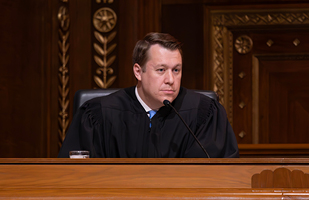Educating Students and Citizens About Appellate Courts

Twelfth District Judge Matthew Byrne hears a Supreme Court oral argument.

Twelfth District Judge Matthew Byrne hears a Supreme Court oral argument.
Twelfth District Court of Appeals Judge Matthew Byrne knows there’s a need for education about the judiciary, especially when it comes to the appellate level. It’s why he’s committed to speaking at schools and community organizations on a frequent basis.
“People are often frustrated with the courts because they don't understand how they work. My goal is for them to get a better grasp of the process should they ever find themselves in court,” said Judge Byrne, who has been on the Twelfth District since 2021.
The role of appellate judges is often overlooked by the public. People more commonly hear about the work and procedures of trial courts as well as state and U.S. supreme courts because of their rank and the major cases they hear. So, Judge Byrne seeks out opportunities to talk about the work done in Ohio’s twelve courts of appeal. Students and community members across his eight-county jurisdiction in southwest Ohio follow up with questions and find out that Judge Byrne hears cases with two other judges.
“It provides perspective on the general working of the courts,” said Judge Byrne. “The audience learns how we provide a second chance to people who don’t think their case at the trial court was fair. Many times, I have to clarify that the appellate court isn’t a second trial with new evidence. We examine constitutional and legal claims about the original trial.”
After an appellate court receives a case, a panel of three judges is assigned to review the claims made by both sides. The court schedules an oral argument where each party has 15 minutes to summarize their positions. During their argument, attorneys field questions from the judges who seek clarity on specific points. The panel then takes the matter under advisement and works collectively to write a decision that might take months before it’s announced.
Judge Byrne explains to students that if a party isn’t satisfied with the decision, they can appeal to the Supreme Court of Ohio. Unlike the appellate courts where people are guaranteed to have their case reviewed, the Supreme Court decides if it will accept a case. At least four of the seven justices must vote in favor of hearing the case that involves a legal issue of public or great general interest.
Judge Byrne recently sat for one such Supreme Court oral argument – Kyser v. Summit County Children Services – after Justice Jennifer Brunner recused. The case raises the question of when a 30-day timeframe begins for appeals of agency decisions. Judge Byrne was assigned to the case by the chief justice, who has Ohio constitutional authority to assign an appeals court judge to sit when there is a justice recusal.
The opportunity allowed Judge Byrne to see how the work of an appellate court was being handled at the state’s highest level.
“Learning about the law is a never-ending journey. And a remarkable experience like serving on the Supreme Court allows me to understand even more about the judicial process from a different perspective, which I’m always happy to share with others,” Judge Byrne said.


